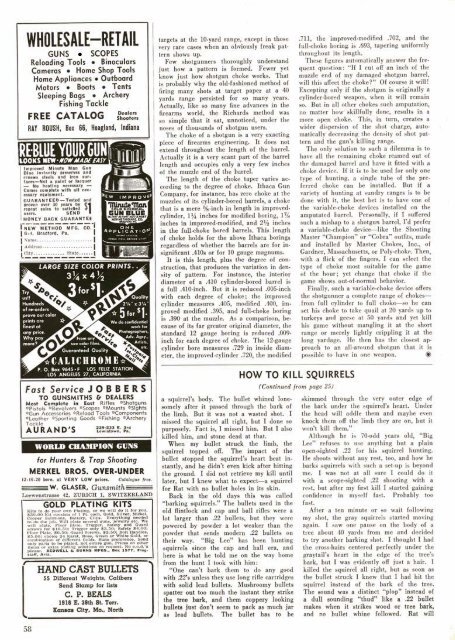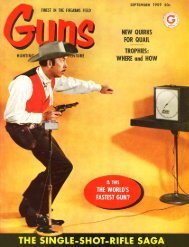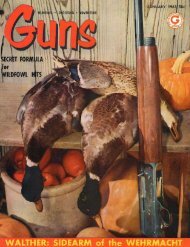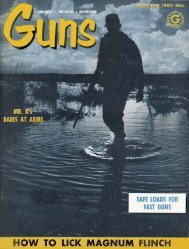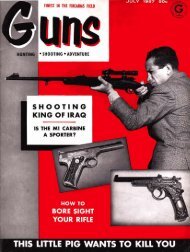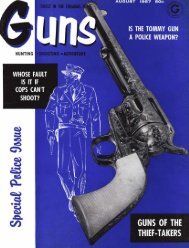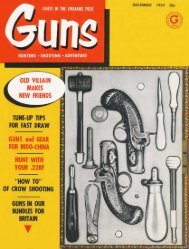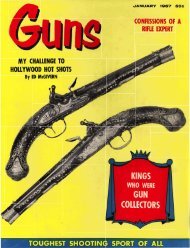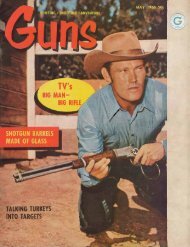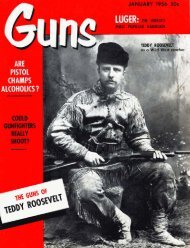You also want an ePaper? Increase the reach of your titles
YUMPU automatically turns print PDFs into web optimized ePapers that Google loves.
WHOLESALE-RETAIL<br />
<strong>GUNS</strong> SCOPES<br />
Reloading Tools 0 Binoculars<br />
Cameras 0 Home Shop Tools<br />
Home Appliances 0 Outboard<br />
Motors 0 Boats 0 Tents<br />
Sleeping Bags 0 Archery<br />
Fishing Tackle<br />
FREE CATALOG es<br />
RAY ROUSH, Box 66, Hoagland, Indiana<br />
Improved Minute Man Gun<br />
Blue instantly preserves and A<br />
renews steels and iron surfaces-Not<br />
a paint or lacquer<br />
- No heating necessary -<br />
Comes complete with all necessary<br />
equipment.<br />
GUARANTEED-Tested and<br />
proven over 30 Years by<br />
repeat sales to satisfied<br />
users. SEND $1<br />
MONEY BACK GUARANTEE<br />
---------<br />
\-NEW METHOD MFG. c0.1<br />
1 G-4, Bradford, Pa. 1<br />
I Name.. ..................... 1<br />
I Address.. ................... I<br />
City.. ........... State .... ..)<br />
L --------- -<br />
SIZE COLOR PRINTS. .<br />
314~4%<br />
LARGE<br />
L<br />
A\<br />
We do confidential<br />
work for<br />
Fast Service J 0 B B E R S<br />
TO <strong>GUNS</strong>MITHS & DEALERS<br />
Most Complete in East Rifles *Shotguns<br />
Â¥Pistol *Revolvers *Scopes *Mounts *Sights<br />
*Gun Accessories *Reload Tools *Components<br />
*Leather 'Sporting Goods -Fishing *Archery<br />
Tackle<br />
A U RA N D 'S<br />
220.233 E. 3rd<br />
Lewistown, Pa.<br />
&jsts; etc.<br />
for Hunters & Trap Shooting<br />
MERKEL BROS. OVER-UNDER<br />
12-16.20 bore. at VERY LOW prices. Oatalooue Ire<br />
= -- W. GLASER, Gunsmith-<br />
Loewenstrasse 42. ZURICH 1, SWITZERLAN<br />
1 GOLD PLATING KITS<br />
itaff, Ariz.<br />
HAND CAST BULLETS<br />
55 Different Weights, Calibers<br />
Send Stamp for lists<br />
C. P. DEALS<br />
1916 E. 39th St. Ten.<br />
Kcmaan City, Mo., North<br />
argets at the 10-yard range, except in those<br />
'cry rare cases when an obviously freak pat-<br />
ern shows up.<br />
Few shotgunners thoroughly understand<br />
ust how a pattern is formed. Fewer yet<br />
mow just how shotgun choke works. That<br />
s probably why the old-fashioned method of<br />
iring many shots at target paper at a 40<br />
rards range persisted for so many years.<br />
actually, like so many fine advances in the<br />
irearms world, the Richards method was<br />
so simple that it sat, unnoticed, under the<br />
loses of thousands of shotgun users.<br />
The choke of a shotgun is a very exacting<br />
piece of firearms engineering. It does not<br />
'xtend throughout the length of the barrel.<br />
Actually it is a very scant part of the barrel<br />
length and occupies only a very few inches<br />
it the muzzle end of the barrel.<br />
The length of the choke taper varies ac-<br />
cording to the degree of choke. Ithaca Gun<br />
Company, for instance, has zero choke at the<br />
muzzles of its cylinder-bored barrels, a choke<br />
that is a mere %-inch in length in improved-<br />
cylinder, 1% inches for modified boring, 1%<br />
inches in improved-modified, and 2% inches<br />
in the full-choke bored barrels. This length<br />
of choke holds for the above Ithaca borings<br />
regardless of whether the barrels are for in-<br />
significant .410s or for 10 gauge magnums.<br />
It is this length, plus the degree of con-<br />
struction, that produces the variation in den-<br />
sity of pattern. For instance, the interior<br />
diameter of a .410 cylinder-bored barrel is<br />
a full .410-inch. But it is reduced .005-inch<br />
with each degree of choke; the improved<br />
cylinder measures .405, modified .400, im-<br />
proved modified .395, and full-choke boring<br />
is .390 at the muzzle. As a comparison, be-<br />
cause of its far greater original diameter, the<br />
standard 12 gauge boring is reduced .009-<br />
inch for each degree of choke. The 12-gauge<br />
cylinder bore measures .729 in inside diam-<br />
eter, the improved-cylinder .720, the modified<br />
a squirrel's body. The bullet whined lone-<br />
somely after it passed through the bark of<br />
the limb. But it was not a wasted shot. I<br />
missed the squirrel all right, but I done so<br />
purposely. Fact is, I missed him. But I also<br />
killed him, and stone dead at that.<br />
When my bullet struck the limb, the<br />
squirrel topped off. The impact of the<br />
bullet stopped the squirrel's heart beat in-<br />
stantly, and he didn't even kick after hitting<br />
the ground. I did not retrieve my kill until<br />
later, but I knew what to expect-a squirrel<br />
for Rat with no bullet holes in its skin.<br />
Back in the old days this was called<br />
"barking squirrels." The bullets used in the<br />
old flintlock and cap and ball rifles were a<br />
lot larger than .22 bullets, but they were<br />
owe red by powder a lot weaker than the<br />
powder that sends modern .22 bullets on<br />
their way. "Big Lee" has been hunting<br />
squirrels since the cap and ball era, and<br />
here is what he told me on the way home<br />
from the hunt I took with him:<br />
"One can't bark them to do any good<br />
with .2Ys unless they use long rifle cartridges<br />
with solid lead bullets. Mushroomy bullets<br />
spatter out too much the instant they strike<br />
the tree bark, and them coppery looking<br />
bullets just don't seem to pack as much jar<br />
as lead bullets. The bullet has to be<br />
.711, the improved-modified .702, and the<br />
full-choke boring is .693, tapering uniformly<br />
throughout its length.<br />
These figures automatically answer the fre-<br />
quent question: "If I cut off an inch of the<br />
muzzle end of my damaged shotgun barrel,<br />
will this affect the choke?" Of course it will!<br />
Excepting only if the shotgun is originally a<br />
cylinder-bored weapon, when it will remain<br />
so. But in all other chokes such amputation,<br />
no matter how skillfully done, results in a<br />
more open choke. This, in turn, creates a<br />
wider dispersion of the shot charge, auto-<br />
matically decreasing the density of shot pat-<br />
tern and the gun's killing range.<br />
The only solution to such a dilemma is to<br />
have all the remaining choke reamed out of<br />
the damaged barrel and have it fitted with a<br />
choke device. If it is to be used for only one<br />
type of hunting, a single tube of the pre-<br />
ferred choke can be installed. But if a<br />
variety of hunting at sundry ranges is to be<br />
done with it, the best bet is to have one of<br />
the variable-choke devices installed on the<br />
amputated barrel. Personally, if I suffered<br />
such a mishap to a shotgun barrel, I'd prefer<br />
a variable-choke device-like the Shooting<br />
Master "Champion" or "Cobra" outfits, made<br />
and installed by Master Chokes, Inc., of<br />
Gardner, Massachusetts, or Poly-choke. Then,<br />
with a flick of the fingers, I can select the<br />
type of choke most suitable for the game<br />
of the hour; yet change that choke if the<br />
game shows out-of-normal behavior.<br />
Finally, such a variable-choke device offers<br />
the shotgunner a complete range of chokes-<br />
from full cylinder to full choke-so he can<br />
set his choke to take quail at 20 yards up to<br />
turkeys and geese at 50 yards and yet kill<br />
his game without mangling it at the short<br />
range or merely lightly crippling it at the<br />
long yardage. He then has the closest ap-<br />
proach to an all-around shotgun that it is<br />
possible to have in one weapon. @<br />
HOW TO KILL SQUIRRELS<br />
(Continued from page 25)<br />
skimmed through the very outer edge of<br />
the bark under the squirrel's heart. Under<br />
the head will addle them and maybe even<br />
knock them off the limb they are on, but it<br />
won't kill them."<br />
Although he is 70-odd years old, "Big<br />
Lee" refuses to use anything but a plain<br />
open-sighted .22 for his squirrel hunting.<br />
He shoots without any rest, too, and how he<br />
barks squirrels with such a set-up is beyond<br />
me. I was not at all sure I could do it<br />
with a scope-sighted .22 shooting with a<br />
rest, but after my first kill I started gaining<br />
confidence in myself fast. Probably too<br />
fast.<br />
After a ten minute or so wait following<br />
my shot, the gray squirrels started moving<br />
again. I saw one pause on the body of a<br />
tree about 40 yards from me and decided<br />
to try another barking shot. I thought I had<br />
the cross-hairs centered perfectly under the<br />
graytail's heart in the edge of the tree's<br />
bark, but I was evidently off just a hair. I<br />
killed the squirrel all right, but as soon as<br />
the bullet struck I knew that I had hit the<br />
squirrel instead of the bark of the tree.<br />
The sound was a distinct "plop" instead of<br />
a dull sounding "thud" like a .22 bullet<br />
makes when it strikes wood or tree bark,<br />
and no bullet whine followed. Rat will


